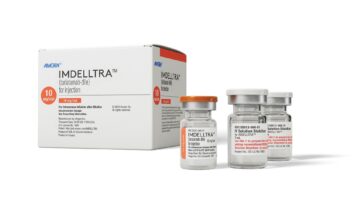
A primary immunodeficiency whose rarity means it can go undiagnosed or misdiagnosed in a patient for years now has its first drug. The FDA has approved a once-daily therapy that addresses the underlying genetic problem driving the inherited disorder, known as WHIM syndrome.
The regulatory decision announced Monday for the X4 Pharmaceuticals drug covers WHIM patients age 12 and older. The daily capsule, known in development as mavorixafor, will be commercialized under the brand name Xolremdi (pronounced “zohl-REM-dee”).
The name WHIM is an acronym for warts, hypogammaglobulinemia, infections, and myelokathexis, which are the four common clinical presentations of the disease. But the disease is not limited to those symptoms and it presents differently from one patient to another. There is no standard of care for WHIM, which is treated with various therapies that address its symptoms and frequent infections.
“What’s exciting about this approval is for the first time, WHIM patients and their physicians have a treatment that targets the underlying cause of the disease,” Paula Ragan, CEO of Boston-based X4, said during a Monday conference call.
There are more than 400 types of primary immunodeficiency, according to the Centers for Disease Control and Prevention. WHIM can confuse patients and clinicians, who either mistake the disease for one of those immunodeficiencies or chalk up the symptoms to children just getting a lot of infections—which many kids do, said Dr. Teresa Tarrant, a professor of rheumatology and immunology at the Duke University School of Medicine and a principal investigator in the X4 drug’s pivotal study. WHIM is suspected when the severity and frequency of infections goes above and beyond what’s typical in most kids, she said in an interview.
WHIM can be thought of as a traffic problem for immune cells. In some immunodeficiencies, the body doesn’t make enough immune cells or the immune cells it makes don’t function properly. In WHIM, functioning immune cells are produced by the bone marrow but they cannot get into circulation to fight pathogens. Myelokathexis, the “M” in WHIM, is the retention of immune cells in the bone marrow. WHIM stems from a rare mutation in the CXCR4 gene, which encodes a chemokine receptor, a protein involved in regulating the movement of immune cells in the body.
The first genetic mutation that leads to WHIM was identified in 2003. Scientific research, including work from X4, has since identified other mutations that lead to the disease. Defective CXCR4 protein keeps the signaling of the CXCR4 pathway in a hyperactive state, which in turn keeps immune cells trapped in the bone marrow, Tarrant said. She likens this pathway to an on-off switch for getting cells out of the bone marrow. X4’s drug is a small molecule designed to selectively target and block the CXCR4 cell receptor.

A Deep-dive Into Specialty Pharma
A specialty drug is a class of prescription medications used to treat complex, chronic or rare medical conditions. Although this classification was originally intended to define the treatment of rare, also termed “orphan” diseases, affecting fewer than 200,000 people in the US, more recently, specialty drugs have emerged as the cornerstone of treatment for chronic and complex diseases such as cancer, autoimmune conditions, diabetes, hepatitis C, and HIV/AIDS.
“In WHIM, many patients have a problem with the off (switch), so the signaling is on all the time,” Tarrant said. “It’s hyperactive. This drug dampens down the hyperactive signaling.”
X4 evaluated mavorixafor in a placebo-controlled Phase 3 clinical trial that enrolled 31 patients with WHIM syndrome. The main goal of the 52-week study was to show a statistically significant increase in time, measured in hours, that neutrophil counts were above a specified threshold. Results showed that the trial met this goal as well as a key secondary endpoint measuring lymphocyte counts. Additional results showed the X4 drug led to statistically significant reductions in annualized infection rates and clinically meaningful reductions in the severity and duration of infections. The drug was well tolerated by study participants.
A rare disease is typically defined as one that affects 200,000 or fewer patients in the U.S. WHIM is ultra rare, affecting about 1,000 people in the U.S., according to X4’s market research. The median age of diagnosis is 5.5 years old. But some patients can go much longer before finding out what’s wrong. Tarrant said her first clinical encounter with WHIM was someone whose disease went undiagnosed until the patient reached the late 30s. While some primary immunodeficiencies can be detected with newborn screening, WHIM is not one of them. These tests only pick up children with extremely low levels of immune cells, Tarrant explained. The low levels in WHIM can be seen in bloodwork. But children typically don’t get a lot of blood draws, she said.
While WHIM can be diagnosed with a genetic test that confirms the CXCR4 mutation, Chief Commercial Officer Mark Baldry noted that the FDA decision does not require it. The label of Xolremdi covers patients who have a clinical diagnosis of WHIM. Xolremdi, available in 100 mg capsules, is dosed according to a patient’s weight. Patients weighing 50 kg (about 110 pounds) or more are directed to take 400 mg once daily. For these patients, the drug’s annual wholesale price is $496,400. Those weighing less than 50 kg will take a 300 mg dose of Xolremdi once daily, which carries a $372,300 annual price. Based on clinical trial experience and company research, X4 estimates that 90% of WHIM patients will require the higher dose. Baldry said Xolremdi is available now, though he added it could take six months to a year before payers start covering it.
Mavorixafor was licensed from Genzyme, a Sanofi subsidiary. With the molecule’s approval, X4 now owes a $7 million milestone payment, plus royalties from product sales, Chief Financial Officer Adam Mostafa said. The company is not providing any sales guidance for the drug at this time. The approval comes with a priority review voucher, which X4 may apply toward faster regulatory review of a different rare disease drug in the future. But companies typically monetize these vouchers, selling them at prices topping $100 million. Mostafa said X4 plans to sell its voucher, and Sanofi-Genzyme is not owed any of the proceeds from that sale.
X4 is also evaluating mavorixafor as a treatment for chronic neutropenia. The company expects to begin a Phase 3 study in this indication by the end of June, according to an investor presentation. The pipeline includes two additional CXCR4-targeting drugs. X4P-003 is a next-generation drug that X4 says has enhanced properties and potential applications in other diseases associated with the CXCR4 receptor. Meanwhile, X4P-002 offers the ability to cross the blood-brain barrier to reach that target. Both molecules are in preclinical development.
Photo: ClarkandCompany, Getty Images














